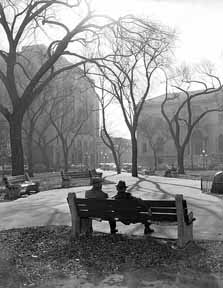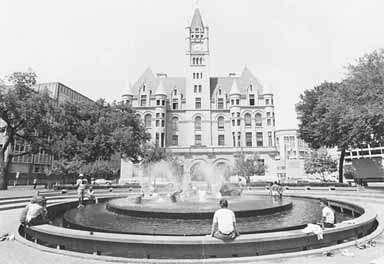Rice Park
Between Washington, Market, 4th, and 5th Streets, St. Paul
| Two men sitting in Rice Park, 1950. Courtesy of the Minnesota Historical Society. |
St. Paul’s small and dense downtown is the result of prehistoric phenomena—glacial melt wore away the Mississippi River’s steep bluffs at the site. This produced an amphitheater-shaped recession on the riverfront, where American settlers later built two steamboat landings on the northern Mississippi’s last naturally navigable point. The city’s landings shipped flour from miles-away Minneapolis at the time, thus secondary businesses such as insurance, banking, and warehousing financed St. Paul’s expansive growth.
|
Perhaps the Twin Cities’ earliest cruising ground, Rice Park sat amid numerous trolley line interchanges and other traffic crossroads. Working-class populations thus crossed paths with office managers, public officials, nearby apartment dwellers, and indigent laborers. At night, the park was a quiet refuge amid these noisy junctions, where queer men from different backgrounds could meet, engage one another, and depart in an anonymous atmosphere. Everyone from West Publishing Company employees to (reportedly) Oscar Wilde used Rice Park.
| The park’s small size inhibited sexual activity within, as the entire green space is visible to passers-by. Thus, men typically met in the park and moved to anther site: perhaps a car, apartment, cheap hotel, or behind some trees along the river.
This activity has diminished with a rekindled municipal interest in the Rice Park (or “Uppertown”) area, and it has likely moved out of downtown. |
Cruising likely diminished after officials redesigned the park in the 1960s. Courtesy of the Minnesota Historical Society. |
This page is still under construciton. -SVC
Part of Minneapolis/St. Paul, MN: 100 Queer Places in Minnesota History, (1860-1969), (1969-2010)

